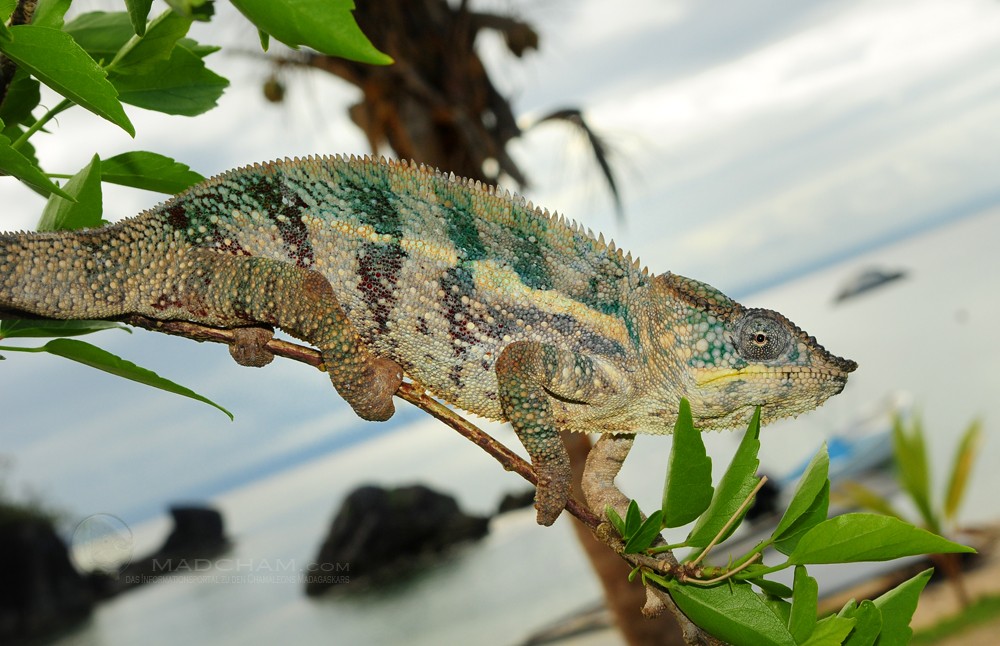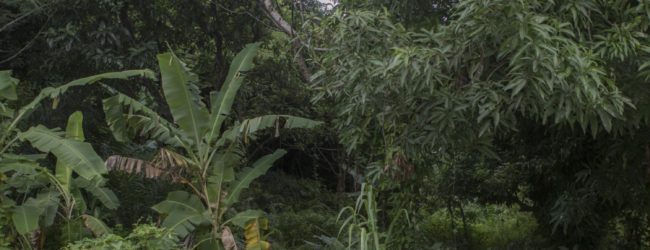Distribution of the local form Nosy Boraha:
The island Nosy Boraha, better known under its French name St. Marie, is located on Madagascar’s east coast in the Indian Ocean, in the region of Toamasina. The largest city of this about 50 km long and two to seven kilometers broad island is Ambodifotatra with 16.000 inhabitants. Most people here subsist on tourism and fishery. The Malagasy name Nosy Boraha means as much as island of Abraham, which traces back to a former Arabic population. Today, a small airport offers daily flights to Antananarivo, otherwise, you can reach St. Marie by boat from Soanierana Ivongo (depending on the waves 2-3 hours drive). Mainly the white dreamlike beaches of St. Marie are famous, in many places, you can snorkel and dive.
Appearance of the local form:
On the island, you can also find a local form of panther chameleons with high color fidelity. Despite its isolation from onshore local forms such as Mahavelona and Soanierana Ivongo, it looks quite similar to those. Males here wear white-greyish colors, partially blueish with rust-red stripes.
Weight table

Gewicht = weight in grams, Kopf-Rumpf-Länge = snout-vent-length in cm, Weibchen = females, Männchen = males
Since 2015 we have been measuring the weights of chameleons we have found in Madagascar, as far as the animals (and our scales) are participating. So far there are only a few weights, in the long term an average weight in relation to the snout-vent-length It is important to know that all weights were measured towards the end of the rainy season (= best food supply), so they are probably maximum weights in Madagascar. Triangular symbols in females do not mean pregnant, round symbols mean pregnant. In the case of Furcifer pardalis, contrary to our original assumption, there have been no serious differences in the ratio of SVL to the weight of the individual local forms.
| Jan | Feb | Mar | Apr | May | Jun | Jul | Aug | Sep | Oct | Nov | Dec | |
| Average temperature | 23 | 24 | 23 | 23 | 21 | 19 | 19 | 19 | 20 | 21 | 22 | 23 |
| Minimum temperature | 20 | 20 | 20 | 19 | 18 | 15 | 15 | 15 | 15 | 16 | 18 | 19 |
| Maximum temperatures | 27 | 27 | 27 | 27 | 27 | 25 | 23 | 23 | 24 | 25 | 26 | 27 |
| Rain days | 18 | 20 | 21 | 13 | 11 | 11 | 15 | 14 | 15 | 16 | 20 | 25 |
We have collected the data given above over several years with thermometers and hygrometers at the finding places of the chameleons. "Average temperature" means that values of a whole month have been calculated to one average value per month. For example all measured minimum temperature values of February have been calculated to one average minimum temperature for February. In plain language, this means single peak values of a day may be a little higher or lower than the average minimum and maximum temperatures. It is possible that a location has an average maximum temperature of 29°C, but one day during that month it had 33°C or even 35°C there.
Nosy Boraha island is located at Madagascar's east coast and has a pleasant warm climate all year long. During rainy season temperatures are a little higher with average temperatures in the 20ies and a slight night drop to 20°C. At daytime it usually has more than 30°C. In dry season, temperatures are a little cooler during day and nighttime.
Precipitation on Nosy Boaha is rather moderate all year long. Rainy season of course has more intense rain, but also "dry" season has regular rainfall. The island is a common destination for foreign tourists and Malagasy vacationers which is mainly due to the mild climate and the beautiful beaches.

We have measured UVB data with a Solarmeter 6.5 in spring (end of March) at the peak of activity of chameleons in Madagascar. We always measured the values that a chameleon could maximally reach in its habitat.
Habitat:
The easiest way to find them is searching the hibiscus hedges along the street from Ambodifotatra to Nosy Nato. Generally, they occur everywhere on the island in bushes, shrubs and trees. They only avoid the beach areas directly at the sea. The ground is a mixture of soil and sand. The small island Nosy Nato has no panther chameleons.





























